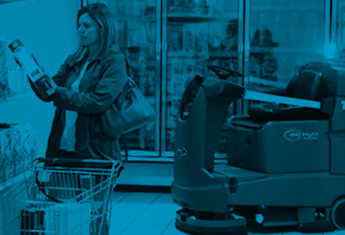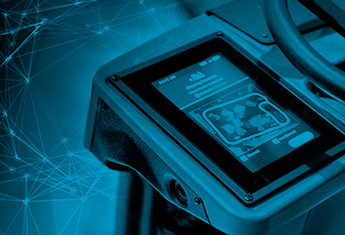Your shopping cart is empty.
Cleaning Technology Trends for 2022
Posted in Staffing & Personnel, Innovation & Technology, Robotic Cleaning Machines,

“Unpredictable” might be the single best word to describe the last two years, so forecasting trends of any sort for 2022 might seem foolish. But it’s always worth trying — especially as organizations plan strategies and budgets for the coming year. There’s also good reason to believe that things are trending toward more stability and predictability.
So, what are the big trends in cleaning technologies for 2022? From robotic cleaning machines and robot janitors to “mechanizing the mop,” they all focus on driving labor efficiency. Let’s take a closer look.
Two Defining Factors: Clean Staying in The Spotlight — Labor Pressure Not Easing
The two driving pressures for 2022 in the cleaning industry will be very familiar. “Clean” remains more business-critical than ever for organizations of all types. One in four people now says that cleaning and sanitation is the top factor in determining which businesses they visit, according to a McKinsey report. And this heightened sensitivity isn’t diminishing: A recent survey found that 9 in 10 people say they’ll remain “extra cautious” about cleanliness — and another study found that 95% of people say they expect businesses to continue doing as much or more cleaning and sanitization1 — even as vaccination numbers increase nationwide. The demand for clean is also coming from employees, and employers are making clean, safe work environments a differentiating way to attract labor.
Labor pressures also aren’t fading anytime soon. The U.S. labor force is missing about 3 million workers, compared to pre-pandemic. And while pandemic concerns are still keeping some workers on the sidelines, there are also more permanent changes. For example, the retirement rate accelerated in 2021, part of a larger trend in which the working-age population in the U.S. has begun to decline for the first time in more than 40 years. And beyond the challenges of the “Great Resignation,” there’s also the so-called “Great Reshuffling”: More people are switching professions entirely — more than half of job changes from May to July of 2021 were from one industry to another2 — which means more new hires with zero experience.
The Challenge For 2022: Doing More With Less
Heightened cleaning demands and a tighter labor market add up to a key challenge that’s also entirely familiar, yet more urgent than ever: Finding ways to do more with less — or, at least, do more, more efficiently. Cleaning & Maintenance Management’s 2021 Benchmarking Survey Report found that 71% of managers say that improving labor productivity and efficiency is a top priority.
With those market dynamics in mind, here are the three major trends in cleaning technologies for 2022:
Trend #1: Robotic Cleaning Machines
Robotic cleaning machines, robot janitors, and other forms of autonomous cleaning technologies were taking off even before the pandemic. For example, in 2019, Walmart announced that it would deploy autonomous robotic floor scrubbers in 1,860 of its stores — and the company had deployed robotic scrubbers in nearly all of its Sam’s Club locations.
A 2019 report estimated that utilization of robotic cleaning machines would grow almost 50% annually over the next decade.3 That adoption was accelerated by the events of the last two years. Brain Corp., the leading provider of AI-powered technology for robotic scrubbers, says it saw a 300% increase in deployments of robotic scrubbers in 2020.
The unique circumstances of 2020 and 2021 certainly amplified the value of robotic cleaning machines. But technological advances also made so-called robot janitors much more capable, consistent and easy to deploy. AI-powered robotic cleaning machines like the Tennant T7 AMR are now truly and reliably autonomous. They can effectively navigate complex environments, from retail to warehouses, without needing human intervention or resets anytime an obstacle presents itself. This makes a “co-bot” approach possible, where robotic cleaning machines work alongside human staff, enabling employees to be re-deployed to other tasks and responsibilities.
The labor efficiency enabled by robotic cleaning machines is significant and rapidly achievable. But it’s not the only value-driving adoption of this technology. Robot janitors can help boost employee engagement (and critically improve retention in a tight labor market) by handling some of the most repetitive and mundane floor cleaning tasks. Robotic cleaning machines also enable organizations to meet rising standards of clean, executing floor cleaning tasks more frequently and with consistent, reliable results — including data-driven proof of coverage.
Trend #2: Mechanized Cleaning In Smaller Spaces
Robotic cleaning machines may be the big, shiny trend, but smaller cleaning machines are becoming the unsung heroes with perhaps an even bigger impact in smaller spaces. That’s because more than 95% of businesses and facilities fit within the “small spaces” category: convenience stores, quick-service restaurants and specialty retailers with around 2,500 square feet or less — as well as small spaces in a larger building, like restrooms, patient rooms and classrooms. These smaller, tighter spaces are still predominantly cleaned with the old mop-and-bucket method. But the heightened focus on cleaning and rising labor pressures are forcing more organizations to confront the problems with mop-and-bucket cleaning — from consistency and performance to safety and water usage.
These small spaces aren’t (yet) candidates for fully autonomous robotic cleaning machines, but more and more organizations are looking to “mechanize the mop,” leveraging floor cleaning technologies like micro-scrubbers and small automatic scrubbers to power greater cleaning performance in their smaller spaces and hard-to-reach areas. In fact, the micro-scrubber market is expected to continue growing at a double-digit pace through 2025.4
Automatic scrubbers combine high-pressure scrubbing with the precise use of detergents to deliver improved cleaning performance over manual mop-and-bucket floor cleaning. Conservative estimates suggest a 100% increase in efficiency — but Tennant studies have found that cleaning with an automatic scrubber can be 8-10x faster than manual mop cleaning.5 In the typical use case, this switch could add up to a savings of 300 hours of labor and nearly $4,500 in labor costs every year.6 And Tennant data indicates that a modern automatic scrubber delivers 90% cleaner surfaces compared to conventional mopping.7
Trend #3: Focus on Flexibility & Versatility of Cleaning Machines
The need for greater labor efficiency is the biggest driver of the adoption of new cleaning technologies, from sophisticated robotic scrubbers to advanced micro-scrubbers. But with bottom-line concerns top-of-mind, versatility of cleaning machines is also top priority. If a business is going to invest in a new cleaning machine, they need it to be more than a one-trick pony.
Fortunately, some of the most advanced automatic cleaning machines, like the Tennant T500 Walk-Behind and the T581 Micro Ride-On Scrubbers, enable organizations to clean a wide range of hard surfaces in their facilities — and can handle everything from light-duty applications to the most rigorous needs. Whether it’s routine cleaning of the aisles of a convenience store, or more difficult cleaning demands of restrooms, or even back-of-house foodservice applications, automatic scrubbers can give an organization a powerful, multi-purpose tool to drive cleaning performance and labor efficiency.
We’re Ready for What’s Next
It’s cliched but true: The only constant is change. That’s become more evident over the last two years, as cleaning teams in organizations of all types recognize the need to be agile and ready for unexpected change. It’s critical to look ahead in terms of your business — the cleaning challenges, customer and stakeholder needs, and operational pressures on the horizon. But it’s also important to look ahead in terms of cleaning technology — understanding how new tools and cleaning machines can help you stay at the leading edge. In a tech-driven world, cleaning technologies will continue to play an increasing role in keeping you operationally successful and protecting your bottom line; helping you meet rising cleaning demands and deliver consistently outstanding cleaning performance; and helping you attract and retain staff by empowering them with the tools and technologies to reduce physical burdens, simplify cleaning tasks and be more successful in their jobs.
As always, Tennant is proud of our legacy of innovation and our commitment to cutting-edge R&D. Moreover, as your trusted partner, we’re here to help you understand how new technologies can help your business — and help you get the most out of them — to ensure that, together, we’re ready for what’s next.

1 Ecolab Post-Vaccine Consumer Attitude Study, July 2021
2 https://www.usatoday.com/story/money/2021/09/07/labor-day-2021-when-worker-shortage-end/5674223001/
3 Commercial & Industrial Robotics 2019, ABI Research
4 From Tennant Commercial Messaging 2020 (source not cited)
5 From Mechanize the Mop white paper
6 Based on ISSA Cleaning Times when cleaning a 2,500 sq. ft. area 5 times per week at $15/hour
RELATED LINKS
Ready to take your cleaning to the next level?
Whether you are requesting a product demonstration or a quote, ordering parts, or making a service appointment, you've come to the right place. Tennant professional representatives are ready with answers to your questions, and we look forward to showing you how much we appreciate your business.
*Required Fields





